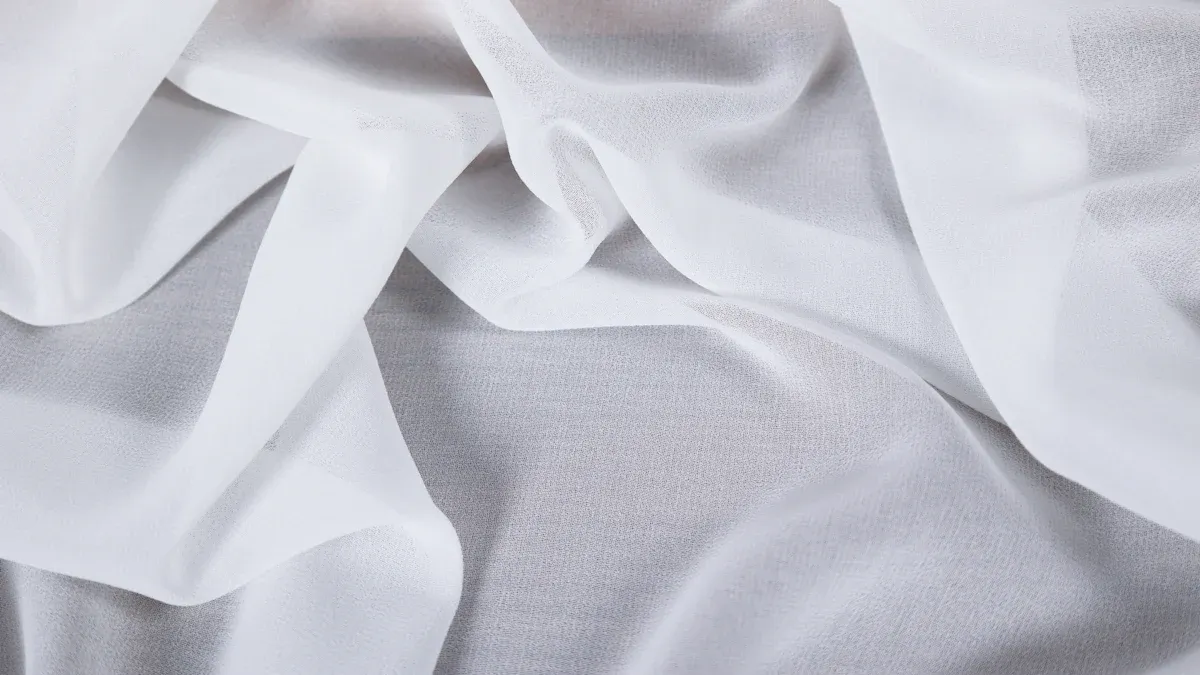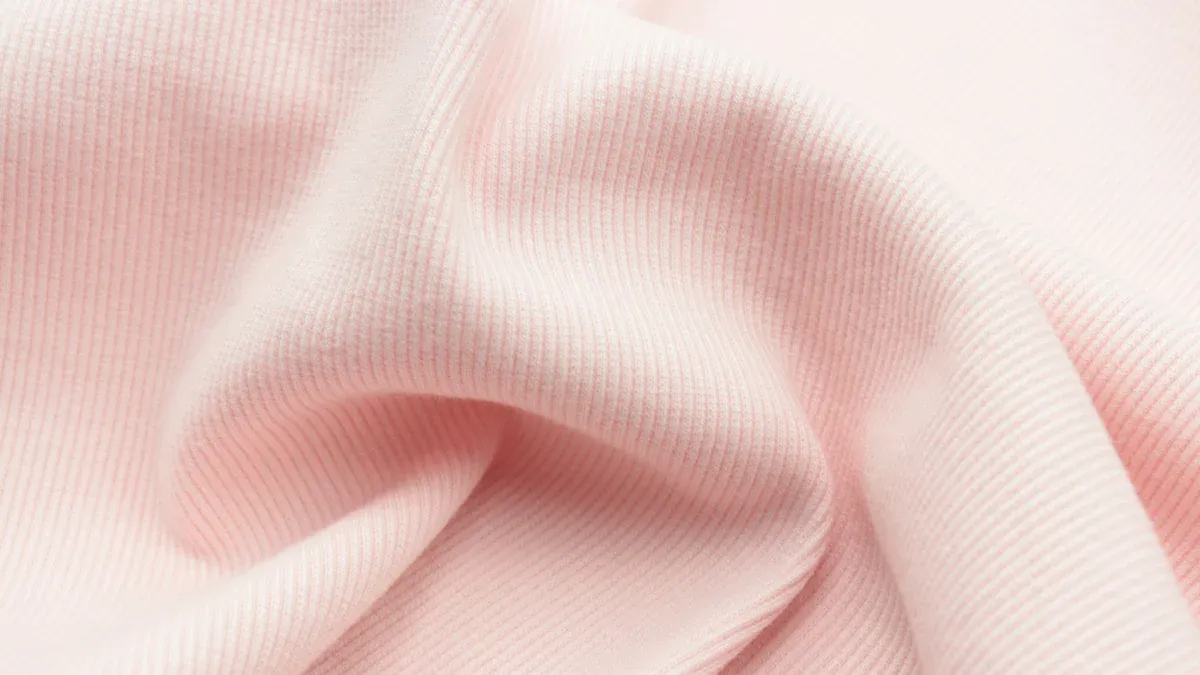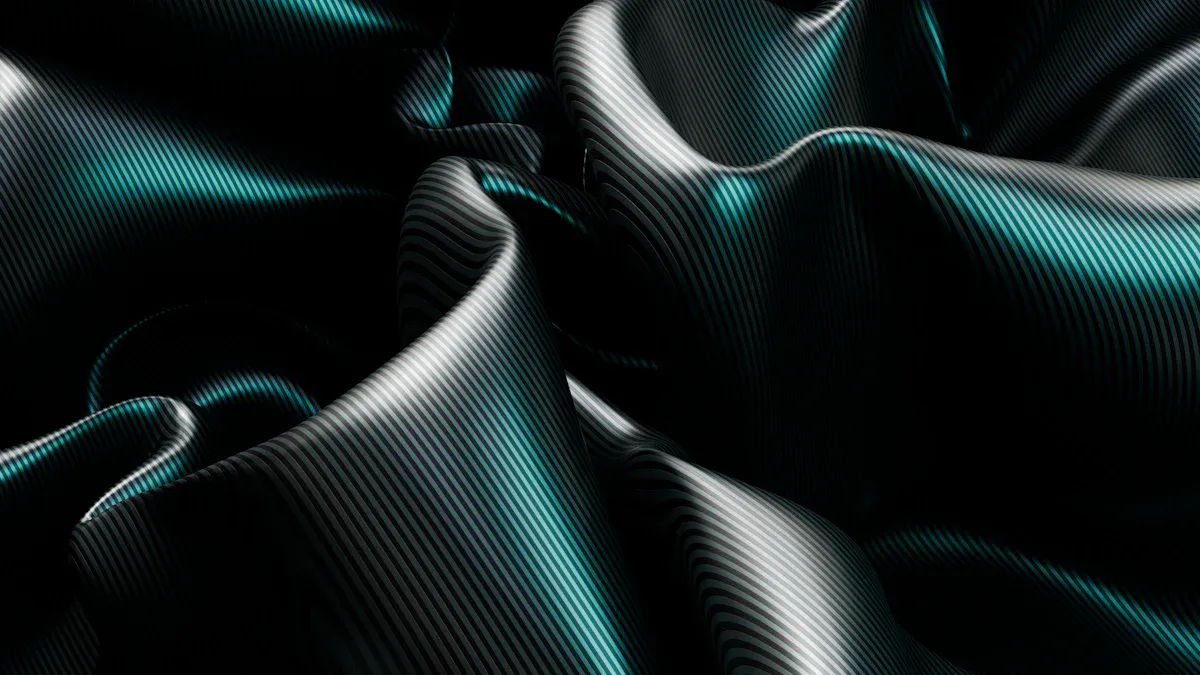Choosing recycled poly chiffon fabric gives you style and helps the environment. When you choose this fabric, you help cut down on waste. You also help make the planet cleaner. Suerte is special in the sustainable fashion world. This is because it uses new technology and follows strict quality rules.
| Production Standard | Innovation Aspect | Sustainability Factor |
|---|---|---|
| GB/T 8971-2016 | Stronger weave methods for longer use | Use of eco-friendly dyes |
| ASTM D5034 | Strong fibers added | Recycled materials in production |
| ISO 105-C06 | UV protection added | Water-based finishing agents |
You get good quality and earth-friendly options. This makes your fashion choices better for the future.
Poly Chiffon Fabric: Basics and Benefits

Features and Qualities
Poly chiffon fabric feels light and soft. It is see-through, so light goes through it. This gives clothes a gentle look. The fabric hangs in smooth, flowing lines. It is great for making pretty dresses and scarves. Poly chiffon does not wrinkle much. Your clothes stay neat for a long time. The fabric lets air in, so you stay cool. It dries fast and feels nice on your skin. Many people like it because it looks like silk. But it is easier to take care of and costs less. You can wash it at home. The color stays bright for a long time. Designers use poly chiffon to make stylish outfits that stand out.
Types and Uses of Poly Chiffon
There are many kinds of poly chiffon fabric. Each kind has its own special features. Here are some types and how they are used in fashion:
| Type of Chiffon | Description | Primary Uses in Fashion Industry |
|---|---|---|
| Silk Chiffon | Luxurious, soft, beautiful sheen, excellent drape | High-end dresses, formal wear |
| Polyester Chiffon | Affordable, durable, less wrinkle-prone, wide color range | Ruffled skirts, outer layers, bridal wear, summer wear |
| Jacquard Chiffon | Intricate woven patterns | Kurtas, dresses, scarves |
| Crinkle Chiffon | Crinkled texture | Casual and semi-formal garments |
| Stretch Chiffon | Contains spandex/elastane for stretch | Comfortable, flexible garments |
You can use poly chiffon for many things. It works for evening gowns, blouses, scarves, and wedding dresses. You can wear it to fancy parties or just every day. Suerte has many choices for color, pattern, and finish. You can make ruffled skirts, loose tops, or layered dresses. Poly chiffon lets you design clothes that are special and feel nice.
Recycled Polyester: Process and Impact
How Recycled Polyester Is Made
Have you ever wondered how old plastic becomes new fabric? The process starts with plastic waste, like used PET bottles. Workers collect these bottles and other scraps. They sort the plastic by color and type. This helps make sure the fabric is good quality. Next, they wash the plastic to get rid of dirt and labels. Clean plastic is then crushed into small flakes. These flakes are dried and melted with heat. The melted plastic goes through tiny holes to make long threads. The threads cool down and are cut into small pieces. Sometimes, these pieces go through a chemical cleaning step. After that, the clean material is melted again and spun into yarn. The yarn is stretched and made soft and strong. At the end, the yarn is dyed and finished. Now it is ready to become recycled polyester fabric. This whole process helps save resources and keeps waste out of landfills. When you pick recycled polyester, you help the planet.
Certifications for Recycled Polyester
You want to know your recycled polyester is safe and high quality. There are special certifications that check this. Here is a table with the most important ones:
| Certification | Minimum Recycled Content | Key Standards and Requirements | Monitoring Body | Notes |
|---|---|---|---|---|
| Recycled Claim Standard (RCS) | 5% (RCS Blended), 95% (RCS 100) | Traceability, transparency, and recycled material content | Independent third parties | Focuses on tracking recycled content |
| Global Recycled Standard (GRS) | 20% (50% for logo use) | Environmental and social criteria, chemical restrictions, traceability, fair labor practices | Independent third parties | Covers full supply chain, more comprehensive than RCS |
| OEKO-TEX® STANDARD 100 | N/A | Tests for harmful substances, ensures safety for consumers | Independent labs | Focuses on safety, not recycled content |
Suerte uses recycled polyester that meets these tough rules. The company checks the fabric with smart machines and AI tools. They look for problems and test the fabric after making it. This keeps the fabric strong, bright, and safe for you. When you choose Suerte’s recycled polyester, you get fabric that is good for the earth and high quality.
Sustainable Fashion Benefits
Reducing Waste
When you pick recycled poly chiffon fabric, you help cut waste. This fabric is made from recycled polyester. The polyester comes from plastic bottles. These bottles might end up in landfills or oceans. Plastic bottles take a very long time to break down. Turning them into fabric keeps them out of nature.
- Each recycled chiffon scarf uses 7 or 8 plastic bottles.
- The process grabs plastic before it reaches land or water.
- Workers wash and sort bottles, then make yarn and fabric.
- This way, less plastic waste harms our planet.
The textile industry makes a lot of waste every year. Less than 1% of old clothes get recycled into new ones. Most polyester stays in landfills for many years. It can also let out bad chemicals. Using recycled materials helps lower waste and saves nature.
Lowering Emissions
Picking recycled polyester also helps lower pollution. Making recycled poly chiffon uses less energy and water. It also makes less carbon dioxide.
- Recycled polyester uses 70% less energy.
- Water use goes down by 86%.
- Carbon dioxide drops by 75% compared to new polyester.
This means your choice helps the earth with every buy. The supply chain for recycled poly chiffon follows strict rules. Certifications like Global Recycled Standard and OEKO-TEX prove it is safe and fair. By picking these fabrics, you help stop climate change and make fashion greener.
Resource Conservation
Recycled poly chiffon fabric helps save important things. You use less oil and water with recycled polyester. This means we need fewer new materials.
- Recycled polyester comes from old plastic, not new oil.
- The process saves up to 90% of water used for new polyester.
- It also uses 59% less energy.
This fabric helps the circular economy. In this system, things get reused and recycled. Recycled polyester can be recycled many times and still be good. This keeps stuff out of landfills and in use. By picking these fabrics, you help make a better future.
Note: Picking recycled poly chiffon helps sustainable fashion. You help cut waste, lower pollution, and save resources. You also help the circular economy and protect the earth for the future.
Consumer Benefits of Recycled Poly Chiffon
Comfort and Style
You want clothes that feel nice and look good. Recycled poly chiffon gives you both things. This fabric feels soft and light on your skin. It hangs well, so your clothes move with you. You can wear it for many hours and not feel hot. The fabric keeps colors bright, even after many washes.
Here is a quick chart to show how recycled poly chiffon compares to other fabrics:
| Fabric Type | Comfort Characteristics | Breathability Characteristics | Sustainability Notes |
|---|---|---|---|
| Recycled Polyester Chiffon | Soft, light, less comfy than cotton | Not as breathable as natural fibers | Made from recycled materials |
| Cotton Chiffon | Very soft, gentle, cool in hot weather | Breathes very well | Biodegradable and eco-friendly |
| Rayon Chiffon | Soft, comfy for long wear | Breathable, but not as strong | Not as eco-friendly as natural fibers |
Recycled poly chiffon is known for its pretty drape and see-through look. You can use it for dresses, blouses, scarves, and wedding gowns. Many designers pick this fabric for its style and many uses. More people want eco-friendly fashion now. You help the earth and look good at the same time.
Durability and Care
You want clothes that last and are easy to clean. Recycled poly chiffon gives you both. The fabric is tightly woven, so it is strong. It feels light but does not tear easily. You can wear it a lot and not worry about wrinkles. This fabric keeps its shape and color for a long time.
- The fabric does not wrinkle much, so you iron less.
- You can wash it by hand with gentle soap to keep it nice.
- Use a steamer instead of an iron to protect the fabric.
- The fabric dries fast, which is good for busy days.
- It lasts a long time, so you can wear your clothes for many seasons.
Suerte gives tips to help you care for your chiffon clothes. Follow their advice to keep your clothes soft, bright, and strong. With recycled poly chiffon, you get comfort, style, and clothes that last.
Common Concerns About Recycled Poly Chiffon
Microplastics: Understanding Shedding and Its Environmental Impact
You might know about microplastics. These are very tiny pieces of plastic. They can come off recycled poly chiffon when you wash it. Washing your clothes can make some fibers break off. These fibers go into the water. Over time, microplastics can end up in rivers and oceans. They can hurt fish and other animals.
You can do things to stop microplastic shedding:
- Wash your recycled poly chiffon clothes less often.
- Use a gentle cycle and cold water.
- Put your clothes in a special bag that catches microfibers.
- Fill your washing machine all the way to lower friction.
- Air dry your clothes instead of using a dryer.
Some people think polyester always feels rough or like plastic. But new recycled polyester, like poly chiffon, feels soft and nice. It can look and feel like silk. New fabric technology makes recycled poly chiffon pretty and comfy.
Tip: If you wash your clothes with care, you help the earth and keep your clothes looking good.
End-of-Life Considerations: What Happens to Recycled Poly Chiffon After Use
Recycled poly chiffon does not break down in nature. It is not biodegradable. When you are done with a piece of clothing, you may wonder what happens next. If you throw it away, it could stay in a landfill for many years.
You have better choices:
- Give your clothes away so someone else can wear them.
- Take them to a place that recycles textiles.
- Find brands that let you return old clothes for recycling.
Some people worry recycled polyester is not strong. This is not true now. Today’s recycled poly chiffon is as strong as regular polyester. Sometimes it is even better. If you pick good fabrics and take care of them, you help the planet. Clothes that last longer make less waste.
There are many certifications for recycled fabrics. But not all are strict or checked by outside groups. You should pick brands that share clear facts about their materials and how they are made. When you buy strong, well-made clothes, you help make fashion better for the earth.
Recycled Poly Chiffon vs. Other Fabrics
Recycled vs. Virgin Polyester
Recycled poly chiffon and virgin polyester are not the same. Virgin polyester is made from oil. Oil is a resource that cannot be replaced. Recycled poly chiffon uses old plastic bottles and waste. This helps save resources and cuts down on pollution.
Here is a table to show the main differences:
| Aspect | Virgin Polyester | Recycled Poly Chiffon (Recycled Polyester) |
|---|---|---|
| Source Material | Petroleum (non-renewable, carbon-intensive) | Post-consumer PET waste (e.g., plastic bottles) |
| Carbon Emissions | High; significant greenhouse gas emissions | Over 70% reduction in GHG emissions per kg compared to virgin |
| Water Pollution | Significant; heavy metals, toxic chemicals, dyes | Reduced due to less virgin material extraction, but still present |
| Microplastic Shedding | Yes; sheds microfibers harmful to marine life | Yes; shares microplastic shedding issues with virgin polyester |
| Durability and Decomposition | Durable; takes thousands of years to decompose | Similar durability and biodegradability challenges |
| Recycling and End-of-Life | Difficult to recycle; mostly ends in landfill/incineration | Difficult to recycle indefinitely; breaks down slightly each cycle |
| Environmental Benefits | None related to resource conservation | Reduces reliance on fossil fuels and lowers carbon footprint |
| Environmental Challenges | Toxic chemical use, water pollution, microplastics | Persistent microplastic pollution and disposal challenges remain |
When you pick recycled poly chiffon, you help the earth. You lower carbon emissions and keep plastic out of landfills. Both fabrics last a long time and do not wrinkle much. But both can shed microplastics when you wash them. Recycled poly chiffon is a better choice for the planet.
Poly Chiffon vs. Natural Fibers
You might wonder how poly chiffon is different from natural fibers. Cotton and silk are natural fibers. They feel soft and let your skin breathe. These fabrics are good for people with sensitive skin. But they need special care. You may have to hand wash or dry clean them. They can shrink or wrinkle easily.
Recycled poly chiffon is not the same. It is easy to care for and does not shrink or wrinkle much. You can wash it at home and it dries fast. But it can trap heat and moisture. It may not feel as cool as cotton or silk.
| Aspect | Natural Fibers | Synthetic Fibers (including recycled poly chiffon) |
|---|---|---|
| Comfort | Soft, breathable, moisture-absorbent; ideal for sensitive skin | Can trap heat and moisture; often less comfortable for prolonged wear |
| Care Requirements | Require delicate care (hand washing, dry cleaning); prone to shrinkage and wrinkling | Easy to care for; machine washable; resistant to shrinking and wrinkles |
Tip: If you want clothes that are easy to care for and last a long time, pick recycled poly chiffon. If you want the softest and coolest fabric, natural fibers are best.
Both types are used in fashion. Each has good points. Your choice depends on what you need most—comfort, easy care, or helping the planet.
Recycled poly chiffon fabric is a good pick for eco-friendly fashion. When you choose it, you help cut down on plastic trash and lower pollution. Suerte makes sure the fabric is soft, strong, and looks nice.
- Recycled polyester is made from PET bottles. This keeps lots of bottles out of landfills.
- Making this fabric uses less energy. It also makes about 75% less CO₂ than new polyester.
- The fabric stays comfy, tough, and pretty for your clothes.
You help make the earth cleaner and still get stylish, top-quality clothes when you choose recycled poly chiffon.
FAQ
What makes recycled poly chiffon fabric eco-friendly?
Recycled poly chiffon is made from plastic bottles and waste. It does not use new oil to make the fabric. This helps keep plastic out of landfills. Making this fabric also saves energy. Using it helps the planet stay clean and lowers pollution.
How do you care for recycled poly chiffon clothing?
Wash these clothes by hand or on a gentle cycle. Use cold water and mild soap to clean them. Let your clothes air dry after washing. Do not twist or wring the fabric. This helps your clothes stay soft and bright.
Does recycled poly chiffon feel different from regular chiffon?
Recycled poly chiffon feels soft and light like regular chiffon. New technology makes it smooth and comfy to wear. You still get the same pretty drape and look.
Can you use recycled poly chiffon for special occasions?
Yes, you can use recycled poly chiffon for fancy events. Designers make dresses, scarves, and gowns with it. The fabric looks nice and flows well. You can wear it to weddings, parties, or every day.



